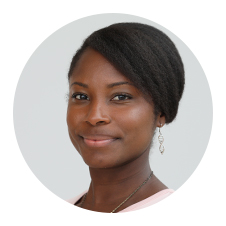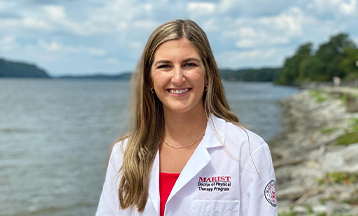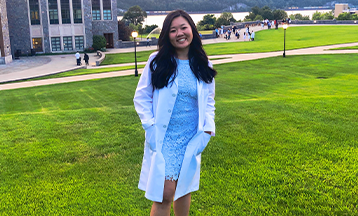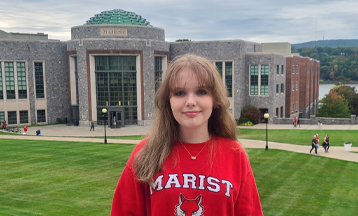-
About
First-Year Application Deadline
Don't miss your chance to apply to Marist and join the Red Fox Family!
• Early Decision II and Regular Decision: Sunday, Feb. 15About
-
Academics
First-Year Application Deadline
Don't miss your chance to apply to Marist and join the Red Fox Family!
• Early Decision II and Regular Decision: Sunday, Feb. 15Academics
-
Admission & Financial Aid
First-Year Application Deadline
Don't miss your chance to apply to Marist and join the Red Fox Family!
• Early Decision II and Regular Decision: Sunday, Feb. 15Admission & Financial Aid
-
Student Life
First-Year Application Deadline
Don't miss your chance to apply to Marist and join the Red Fox Family!
• Early Decision II and Regular Decision: Sunday, Feb. 15Student Life
- Athletics
Students talking to each other in front of posters

Kadeine Campbell Peterson
Exeter, NHAcademic School
ScienceCampus
New YorkIt’s been a busy 10 years since Kadeine Campbell Peterson ’09 graduated from Marist with a degree in biology. She went on to earn a master’s in genetics at Cornell University and taught science at The Hotchkiss School in Lakeville, Connecticut and the Packer Collegiate Institute in Brooklyn before accepting a teaching position at Phillips Exeter Academy in Exeter, New Hampshire. She is married to fellow Marist alumnus Joshua Peterson ’09, and they are the parents of two sons, Jack Maverick (5) and Kingston (1). We spoke to Campbell Peterson recently about her career trajectory, how Marist prepared her for success, and the responsibility she feels as a woman of color at an elite boarding school.
Why did you make the switch from being a research scientist to teaching in a secondary school? Did it end up being the right choice?
I ultimately decided to leave the bench because I fell out of love with the research. I decided to pursue science at a higher level specifically because I loved ALL aspects of the field, but research had effectively pigeonholed me into one topic. Teaching allowed me to spread my wings again in a way that I am finding both fulfilling and fun. It was absolutely the right choice for me, and I love being an integral part of the learning process.
What’s a typical day for you at Exeter? What courses do you teach and what other activities are you involved in?
A typical teaching day for me begins at 8 am and will go until about 5:30 pm. I currently teach two levels of general biology and will be co-teaching a research course next spring. Since Exeter is a boarding school, my day does not end once I leave the classroom. Instead, I fall into my role as a dorm parent to 40 students. Depending on the night, this may mean walking around the dorm to touch base with them or baking cookies for a late-night snack. It’s wonderful to have the ability to connect with my students outside of the classroom.
You’ve taught at some extremely elite prep schools (Packer, Hotchkiss, Exeter). What’s that experience been like? Are the students what you expected? Is it rewarding?
I have been very fortunate with the places I’ve worked. All of the schools are very well funded, which meant that I had the freedom, and in most cases, the autonomy to teach the material the way I wanted. What I didn’t expect was how engaged the students would be. At Exeter, we teach using the Harkness method, a student-centered/flipped-classroom model developed here decades ago. Harkness allows for meaningful and open discussions between the students with me serving as facilitator. It is fun to actually watch the process of learning occur around the Harkness table every day. It’s a lot of work, but incredibly rewarding.
How did your Marist educational experience prepare you for the career success you have enjoyed?
Marist was where I learned how to ask a good question. This may seem arbitrary until you try to formulate a good research question! Additionally, the combination of science classes and involvement in the Celebration of Undergraduate Research, Scholarship, and Creative Activity (CURSCA) really marked my first foray into the world of the research sciences. These experiences set me on the path to the career I have today.
You’ve said that you feel a responsibility to serve as a role model for students of color at the schools you’re in. Talk some more about that sense of responsibility and the importance of students seeing a face that looks like theirs in the classroom.
It wasn’t until I became a teacher that I realized just how impactful my presence in a science classroom, and even in a given school, would be. I’m unsure why it never occurred to me previously, but I didn’t have any black teachers – and certainly no black female teachers – throughout high school and college. There is a phrase used among people doing diversity, equity, and inclusion (DEI) work, this concept of “windows and mirrors.” What this essentially means is that students should be exposed to educational examples that serve as windows into an experience unlike their own, as well as mirrors for experiences in which they can see themselves. I am a strong believer in this principle and feel as if the majority of my responsibility towards my students is to serve as a mirror for those it applies to and as a window for everyone else. In a recent article in the school paper, a former student of mine (who identifies as a black female) commented that her confidence both in herself and her abilities to succeed in biology felt deeply tied to the fact that she had a role model in the classroom. That was an incredibly touching moment for me, as I often feel like I am doing so little towards adding to the DEI toolkit at my school. Knowing that my presence was a driving force in how she saw herself in the future was a good reminder, in part, of why it is I remain in these predominantly white spaces doing the work that I do.
You’re the mother of two small boys – what crosses your mind when you think about raising them as black men in America? What are you hoping to instill?
Our two sons are of mixed heritage, but will be seen and identified by the world as black boys – and then men – as they grow. My most recent job change brought us to the second whitest state in America, a fact that has been keeping me up at night lately. Jack is about to begin kindergarten next year, and this moment will mark his first foray out of the private nursery school bubble. As a point of note, the nursery schools that both my children attend are less homogenous than the local public school because they are populated by the children of our diverse boarding school faculty. As such, my husband and I are constantly reassessing what lessons both of our sons need to be taught for their survival in a country that hasn’t necessarily shown much love or respect to people who look like them. I am hoping to instill in them the knowledge that they are strong, smart, and worthy of respect. Someone hearing this may question if these aren’t things we should be instilling in ALL children, but I would argue that I was very deliberate with my phrasing. We currently live in a country that is either showing black boys that they are unworthy and criminalized or only made important by their sports ability. I want to make sure that my sons are armed with the tools they need to navigate such a stifling world with many unfair expectations placed upon them simply by virtue of their birth.
Where do you see your career leading you?
If you had asked me if I would be teaching 10 years ago, I would have told you with certainty, NO. I was so sure that I wanted to end up as a Principal Investigator deep in a lab somewhere, studying meiosis and infertility. I initially began teaching to satisfy a requirement for a totally different job at the Smithsonian in their science education department. As fate would have it, I ended up really enjoying being in the classroom and now plan on remaining on this path for a very long time.
You recently accepted an offer to join Marist’s new Diversity and Inclusion Alumni Advisory Board. What do you hope to gain from the experience and what does it mean to you that Marist has formed this committee?
I was incredibly excited to be invited to join the Advisory Board. My professional career has offered me many opportunities to increase my DEI awareness, and I am hoping that involvement with this board adds to that in a way that could help me take on a more prominent role on a similar committee at my place of work. For me, it is significant that this committee was formed on the eve of my 10th reunion. So much has changed for me over the past 10 years, including my involvement with social justice work. For the first time, I feel as if I am truly confronting the trauma of some of my experiences being a black woman in the field of science. I talked about the ideas of windows and mirrors being important for my students, but it also applies to me. I see my younger self mirrored in my black female students and think of all the lessons I would have liked to have learn at that age and through college. I am hoping that the work of the Alumni Diversity and Inclusion Board works to address all areas of DEI on campus and beyond so that all students have an equitable experience while there and that they leave with the tools needed to navigate their world upon graduation.
Your 10th Marist reunion is this fall. When you look back on the last 10 years personally and professionally, what thoughts come to mind?
So much has changed for me over the past 10 years; I’ve increased my education, gotten married, had two children, and settled into a career. Through it all, my husband Joshua has been the wonderful constant. We are both looking forward to looking backward as we reminisce with our fellow Red Foxes about how the past decade has gone for us. I cannot wait to return to the Hudson Valley with my family in tow to see all the things that have changed, but also to take comfort in the things that have stayed the same.



